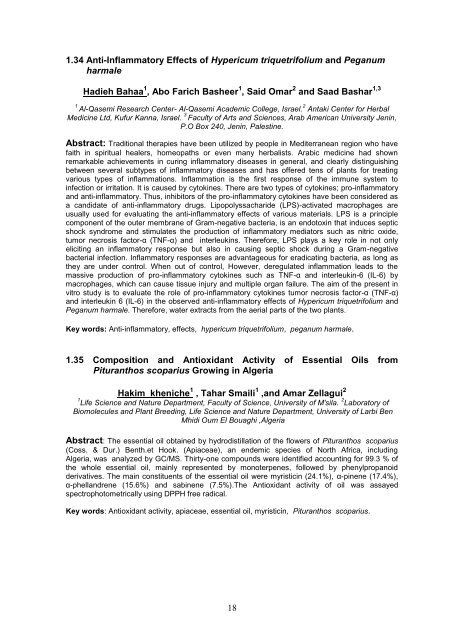Abstract Book - 3rd International Symposium on Medicinal Plants ...
Abstract Book - 3rd International Symposium on Medicinal Plants ...
Abstract Book - 3rd International Symposium on Medicinal Plants ...
Create successful ePaper yourself
Turn your PDF publications into a flip-book with our unique Google optimized e-Paper software.
1.34 Anti-Inflammatory Effects of Hypericum triquetrifolium and Peganum<br />
harmale<br />
Hadieh Bahaa 1 , Abo Farich Basheer 1 , Said Omar 2 and Saad Bashar 1,3<br />
1<br />
Al-Qasemi Research Center- Al-Qasemi Academic College, Israel. 2 Antaki Center for Herbal<br />
Medicine Ltd, Kufur Kanna, Israel. 3 Faculty of Arts and Sciences, Arab American University Jenin,<br />
P.O Box 240, Jenin, Palestine.<br />
<str<strong>on</strong>g>Abstract</str<strong>on</strong>g>: Traditi<strong>on</strong>al therapies have been utilized by people in Mediterranean regi<strong>on</strong> who have<br />
faith in spiritual healers, homeopaths or even many herbalists. Arabic medicine had shown<br />
remarkable achievements in curing inflammatory diseases in general, and clearly distinguishing<br />
between several subtypes of inflammatory diseases and has offered tens of plants for treating<br />
various types of inflammati<strong>on</strong>s. Inflammati<strong>on</strong> is the first resp<strong>on</strong>se of the immune system to<br />
infecti<strong>on</strong> or irritati<strong>on</strong>. It is caused by cytokines. There are two types of cytokines; pro-inflammatory<br />
and anti-inflammatory. Thus, inhibitors of the pro-inflammatory cytokines have been c<strong>on</strong>sidered as<br />
a candidate of anti-inflammatory drugs. Lipopolyssacharide (LPS)-activated macrophages are<br />
usually used for evaluating the anti-inflammatory effects of various materials. LPS is a principle<br />
comp<strong>on</strong>ent of the outer membrane of Gram-negative bacteria, is an endotoxin that induces septic<br />
shock syndrome and stimulates the producti<strong>on</strong> of inflammatory mediators such as nitric oxide,<br />
tumor necrosis factor-α (TNF-α) and interleukins. Therefore, LPS plays a key role in not <strong>on</strong>ly<br />
eliciting an inflammatory resp<strong>on</strong>se but also in causing septic shock during a Gram-negative<br />
bacterial infecti<strong>on</strong>. Inflammatory resp<strong>on</strong>ses are advantageous for eradicating bacteria, as l<strong>on</strong>g as<br />
they are under c<strong>on</strong>trol. When out of c<strong>on</strong>trol, However, deregulated inflammati<strong>on</strong> leads to the<br />
massive producti<strong>on</strong> of pro-inflammatory cytokines such as TNF-α and interleukin-6 (IL-6) by<br />
macrophages, which can cause tissue injury and multiple organ failure. The aim of the present in<br />
vitro study is to evaluate the role of pro-inflammatory cytokines tumor necrosis factor-α (TNF-α)<br />
and interleukin 6 (IL-6) in the observed anti-inflammatory effects of Hypericum triquetrifolium and<br />
Peganum harmale. Therefore, water extracts from the aerial parts of the two plants.<br />
Key words: Anti-inflammatory, effects, hypericum triquetrifolium, peganum harmale.<br />
1.35 Compositi<strong>on</strong> and Antioxidant Activity of Essential Oils from<br />
Pituranthos scoparius Growing in Algeria<br />
Hakim kheniche 1 , Tahar Smaili 1 ,and Amar Zellagui 2<br />
1 Life Science and Nature Department, Faculty of Science, University of M'sila. 2 Laboratory of<br />
Biomolecules and Plant Breeding, Life Science and Nature Department, University of Larbi Ben<br />
Mhidi Oum El Bouaghi ,Algeria<br />
<str<strong>on</strong>g>Abstract</str<strong>on</strong>g>: The essential oil obtained by hydrodistillati<strong>on</strong> of the flowers of Pituranthos scoparius<br />
(Coss. & Dur.) Benth.et Hook. (Apiaceae), an endemic species of North Africa, including<br />
Algeria, was analyzed by GC/MS. Thirty-<strong>on</strong>e compounds were identified accounting for 99.3 % of<br />
the whole essential oil, mainly represented by m<strong>on</strong>oterpenes, followed by phenylpropanoid<br />
derivatives. The main c<strong>on</strong>stituents of the essential oil were myristicin (24.1%), α-pinene (17.4%),<br />
α-phellandrene (15.6%) and sabinene (7.5%).The Antioxidant activity of oil was assayed<br />
spectrophotometrically using DPPH free radical.<br />
Key words: Antioxidant activity, apiaceae, essential oil, myristicin, Pituranthos scoparius.<br />
18

















